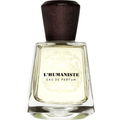
Timaru
Reviews
Detailed
Translated · Show original
"More Aura than Scent" or "How Non-Nose People Should Perceive Perfume"
Much has already been said about the scent and how it smells.
My associations would be, warm (paradoxically, cool also fits), smooth, wooden metal. I do not perceive it as powdery.
I find it fascinating how clearly the difficulty comes across in the comments that we have in describing completely artificial "new" scents. My intuition first goes to colors and temperature, see above, possibly also materials. But I digress...
However, I would like to share 2-3 other thoughts:
What fascinates me about Iso E Super is the way of perception. I myself walk on the edge of the ability to smell. Pure (and freshly applied), I can hardly smell it, but I recognize that it is there. Like an aura that influences the overall appearance without one being able to say how.
As a component of perfumes, it is distinctive and usually quite identifiable. What it does to these perfumes, how it influences and changes them, can only be guessed by those who have tried to incorporate it into compositions themselves. A fascination par excellence. Truly wondrous, however, is the development of the scent and the symbiosis it enters with the wearer's natural scent. I can smell pure Molecule 1 better after 2 hours than immediately upon spraying, and then always fundamentally individually different from wearer to wearer. The fact that the perception is likely also different from nose to nose makes the mystery complete.
But the most interesting phenomenon for me is the following:
When I find myself in the vicinity of Molecule 1, I always need 1-2 seconds to identify the sensory impression as a scent; the smell resonates directly somewhere in my brain. I can then categorize it, analyze it, etc., but the first impulse is always surprise and wonder.
I imagine this is how non-fragrance enthusiasts must perceive perfume. A sensory impression that flies under the radar, is perceived, elicits a reaction (joy, disgust, surprise, etc.), and can then only be categorized.
Fascinating.
In the history of the art of perfumery, a milestone that can hardly be overestimated, just like Ambroxan (and in my eyes, for example, Dihydromyrcenol)!
My associations would be, warm (paradoxically, cool also fits), smooth, wooden metal. I do not perceive it as powdery.
I find it fascinating how clearly the difficulty comes across in the comments that we have in describing completely artificial "new" scents. My intuition first goes to colors and temperature, see above, possibly also materials. But I digress...
However, I would like to share 2-3 other thoughts:
What fascinates me about Iso E Super is the way of perception. I myself walk on the edge of the ability to smell. Pure (and freshly applied), I can hardly smell it, but I recognize that it is there. Like an aura that influences the overall appearance without one being able to say how.
As a component of perfumes, it is distinctive and usually quite identifiable. What it does to these perfumes, how it influences and changes them, can only be guessed by those who have tried to incorporate it into compositions themselves. A fascination par excellence. Truly wondrous, however, is the development of the scent and the symbiosis it enters with the wearer's natural scent. I can smell pure Molecule 1 better after 2 hours than immediately upon spraying, and then always fundamentally individually different from wearer to wearer. The fact that the perception is likely also different from nose to nose makes the mystery complete.
But the most interesting phenomenon for me is the following:
When I find myself in the vicinity of Molecule 1, I always need 1-2 seconds to identify the sensory impression as a scent; the smell resonates directly somewhere in my brain. I can then categorize it, analyze it, etc., but the first impulse is always surprise and wonder.
I imagine this is how non-fragrance enthusiasts must perceive perfume. A sensory impression that flies under the radar, is perceived, elicits a reaction (joy, disgust, surprise, etc.), and can then only be categorized.
Fascinating.
In the history of the art of perfumery, a milestone that can hardly be overestimated, just like Ambroxan (and in my eyes, for example, Dihydromyrcenol)!
8 Comments






